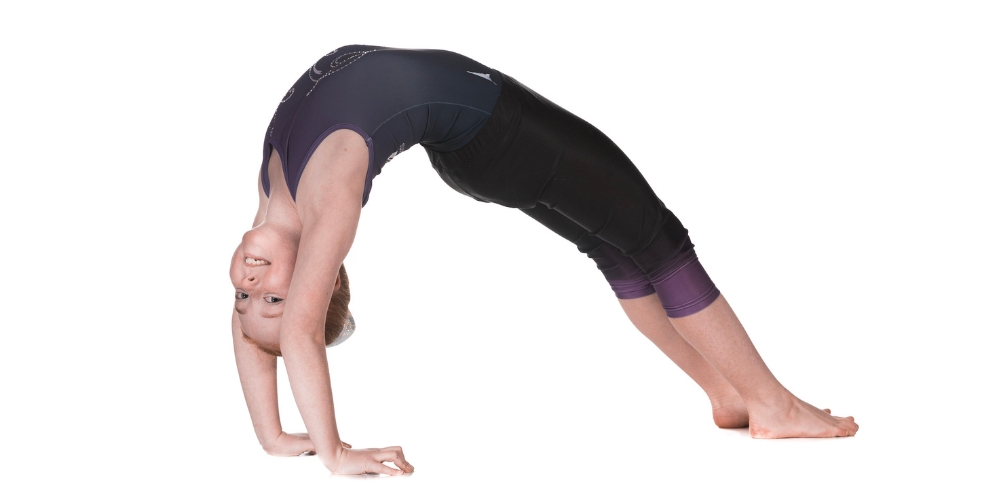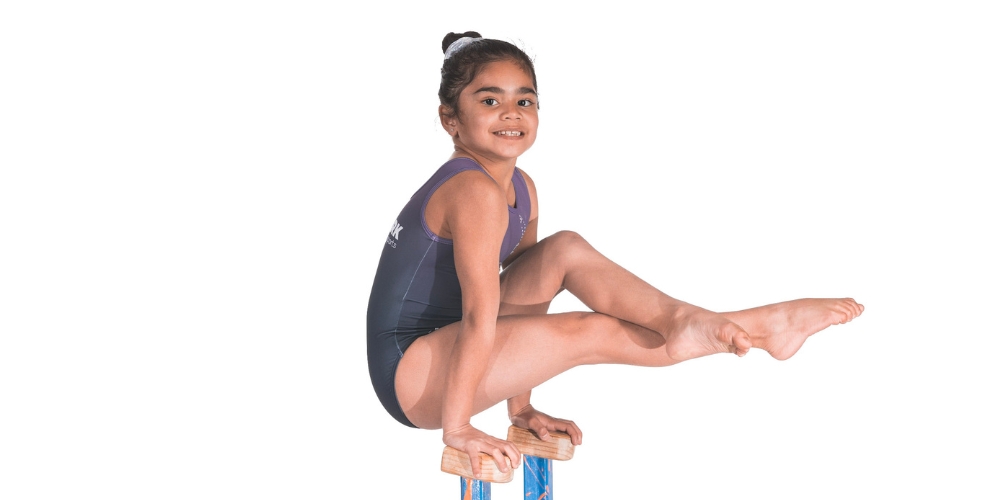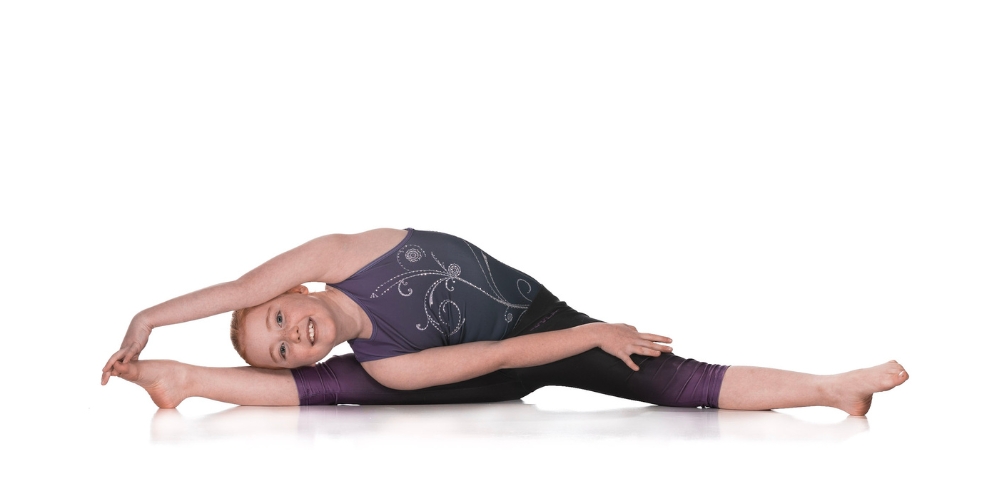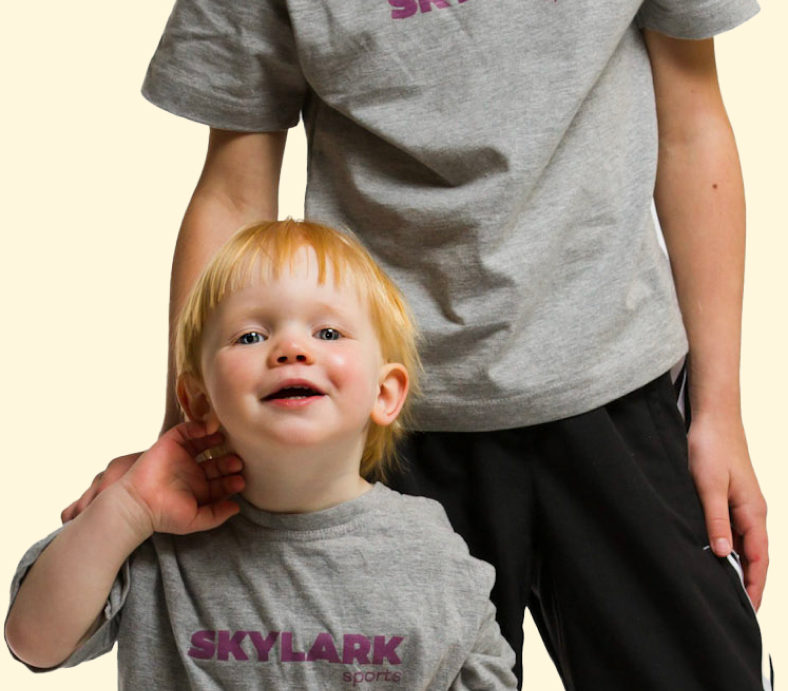The most common question among parents is, "What's the first skill my kid should learn first?"
If you look at it, it may look so overwhelming. And that's fine! That's why we are here. We, gymnastics coaches, would like to help everyone's enthusiasm to learn the sport by making it more fun.
That's why we've created the ultimate list of gymnastic skills and broken them down into manageable steps. Our goal is to provide a clear roadmap, making the journey into gymnastics educational and enjoyable for beginners.
Let's get started!

Bodyweight Skills
Bodyweight skills are physical movements or exercises that use an individual's body weight for resistance and performance, requiring strength, flexibility, balance, and coordination.
Here are the most common bodyweight skills to learn for those who are starting with gymnastics:
Cartwheels
To begin, place your feet shoulder-width apart. Raise one arm aloft and kick the other leg sideways as you lower it. Kick the second leg over your torso while keeping your hands on the ground. Continue honing this movement while progressively picking up speed. Keep your composure and balance throughout the exercise.
Handstands
Use a wall as support at first. With your hands shoulder-width apart, raise one leg and then progressively raise the other leg such that it leans against the wall. To find balance, practise shifting your weight with your hands. As you become more comfortable, try holding the handstand away from the wall while emphasising a straight body line and core engagement.
Forward Rolls
Place your hands on the ground as you begin in a squat. Roll forward, tuck your chin into your chest, and utilise your momentum to stand back up. First, practise on a softer surface to ensure a controlled and smooth roll. Work on keeping the roll tucked in and expanding it gradually for more fluidity.
Backward Rolls
Sit on the ground with your feet flat and knees bent to start. With your fingers pointing back, place your hands behind you. Tuck your chin into your chest as you raise your hips and roll back. To manage and support the roll, use your hands. Work on rolling from a standing position gradually, keeping your action smooth and controlled.
Bridge
Lie flat on your back, your feet on the floor, and your knees bent. Place your hands next to your head with your fingers pointed towards your shoulders. Lift your hips and form an arch by applying pressure with your hands and feet. While maintaining a straight posture, use your core. As your flexibility increases, practise holding the bridge posture longer.

Vaulting Skills
Vaulting skills involve using a springboard or vaulting table to perform acrobatic manoeuvres, showcasing a combination of strength, speed, and precision commonly associated with artistic gymnastics.
Handsprings
Start practising a handstand against a wall to strengthen your upper body. Next, concentrate on kicking one leg forward and generating a slight spring by pushing off with your hands. To achieve a controlled landing, gradually raise the spring's height and practise bringing both legs together. Throughout the exercise, emphasise good hand placement and core activation.
Round offs
Start with a sturdy standing position. As you begin the roundoff, sweep one arm down and across your torso while kicking one leg up. Use the momentum to complete a fast cartwheel and land on both feet—practice in a straight line with a smooth and seamless transition. As you practise the roundoff technique, gradually improve your speed and precision.
Moonwalks
The moonwalk is a dancing movement that gives the illusion of gliding backwards. Begin by standing one foot in front of the other. Shift your weight to the back foot and slide the front foot backwards without raising it off the ground. Repeat this motion with the opposite foot to get a continuous gliding effect. Concentrate on the sliding action and practise remaining balanced during the moonwalk.
Floor Skills
Front Walkover
Start in a standing position with your feet together. Step forward with one foot and extend both arms overhead. Place your hands on the ground and kick your back leg over, straightening it. Shift your weight to your hands and front foot, enabling the back leg to follow easily. Practice on a padded surface, focusing on fluid movements and maintaining a straight line.
Back Walkover
Start in a standing position. Reach both arms aloft and lean backwards, hands on the ground. Kick one leg above your head while pushing with your hands and keeping a firm core. Allow the second leg to follow and finish the walkover. Start with a spotter, focusing on flexibility and control throughout the exercise.
Front kicks
Stand with your feet shoulder-width apart. Lift one leg forward, aiming at the highest point possible while remaining straight. Focus on activating the core for balance and control. Lower the leg back down and repeat on the opposite side. Begin with moderate and controlled motions, gradually increasing pace as you gain strength and flexibility.
Back Kicks
Start standing with your feet shoulder-width apart. Lift one leg backwards, aiming for the highest height possible while remaining straight. Maintain equilibrium by engaging your core muscles. Lower the leg back down and repeat on the opposite side. Concentrate on controlled motions and gradually increase the height of the kick as you gain flexibility and strength.

Tips for a Fun Start to Gymnastics
Make the Gym a Happy Place
Create an environment in the gym that seems like a second home. Encourage everyone to maintain a cheerful and upbeat attitude, whether they are just starting or have been doing it for a while. Everyone may feel at ease and motivated when they see friendly faces, hear encouraging cheers, and are in a warm environment.
Get Good at the Basics
Consider gymnastics like learning to ride a bike. You want to master the fundamentals because they lay the groundwork for everything else. Spend time practising basic techniques and skills. It's like laying a solid foundation for a house; it makes the entire construction more stable.
Do Your Own Thing
Gymnastics is a personal journey. Find exercises and routines that align with your interests and preferences. Enjoy the process and make it your own. When you're doing something you enjoy, the overall experience improves.
Give High Fives for Progress!
Celebrate every achievement, no matter how big or tiny! If someone makes a new move or improves in any manner, show your appreciation by giving them a high five or a nice pat on the back. Positive feedback goes a long way towards increasing confidence and creating a supportive group.
Add Fun Challenges
Make your training sessions more interesting by incorporating amusing challenges. It might be a friendly competition, creating a fun obstacle course, or introducing skill-based games into your routine. These obstacles make studying and practising gymnastics more interesting and pleasurable.
Help Each Other Out
Gymnastics is a team effort. Be a good sport and help your other gymnasts. If you see someone struggling with a relocation, offer some polite advice or aid. Creating a friendly community within the gym improves the overall experience for everyone.
Keep Smiling
Remember to have fun! Gymnastics is more than physical skill; it's about having fun along the way. Wear a smile, face the obstacles, and enjoy the successes. A cheerful mindset can make the gymnastics experience more rewarding and pleasurable.
Frequently Asked Questions
How can I keep motivated in gymnastics when improvement is slow?
Progress in gymnastics takes time. Set tiny, attainable goals, monitor your progress, and appreciate each achievement. Also, change up your routine to keep things new, and remember to appreciate the effort you're putting in.
Are there special workouts that enhance flexibility for gymnastics?
Absolutely! Along with regular gymnastics training, incorporate dynamic stretching, yoga, and focused exercises for the shoulders, hips, and hamstrings. Incorporate these into your regimen to improve flexibility and avoid injuries.
Can I practice gymnastics at home without equipment?
Yes, you can! While professional coaching is ideal, there are plenty of bodyweight exercises, flexibility drills, and basic skills you can practice at home. Always prioritise safety and proper form.
Can I wear any clothing for gymnastics?
While there's no strict dress code, it's advisable to wear form-fitting, flexible attire that allows for a wide range of movement. Avoid clothing with zippers or buttons to prevent injuries.
Conclusion
You may find many gymnastics training programs for beginners, and our list may look different. However, when it comes down to it, what's most important is that you enjoy what you're doing. Our list of tips might differ from what others suggest, but that's okay. The main thing is to find what feels right for you.
Different programs might have ways of doing things, but the main idea is to have fun and feel good about learning.
Whether doing flips on a beam or trying out the parallel bars, getting better at gymnastics is about having fun along the way. Keep trying new things, celebrating the small wins, and, most importantly, having a blast in every part of your gymnastics adventure.
And most importantly, choose the right gymnastic coach. Trust me, they are the key towards the achievement of your goals!

